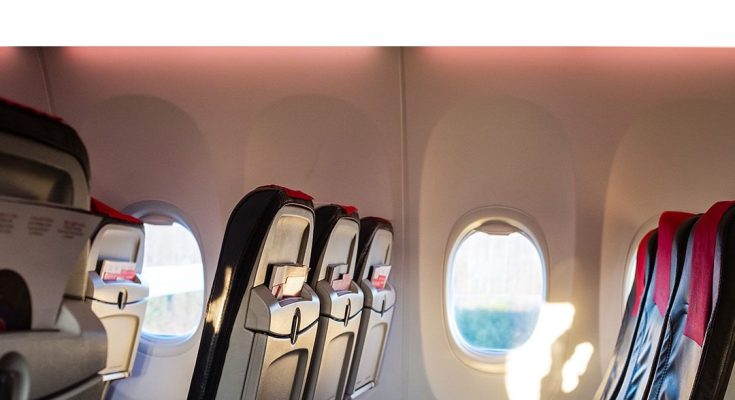Whether you’re taking a seven-hour trip across the pond to Europe or embarking on the nearly 19-hour odyssey from New York City to Singapore, a long-haul flight can be boring, uncomfortable, and exhausting. The nuisances of time-consuming air travel can range in severity from mildly inconvenient (annoying seat mates, let’s say) to the downright dangerous (developing a blood clot on a plane is no joke). Luckily, there are some easy ways to make a big journey more bearable. Here are 32 of our favorite tips for long flights.
:max_bytes(150000):strip_icc():format(webp)/reading-in-economy-COMFYFIGHT0821-5eb51edb07684f92b8383ed3de9c2cb8.jpg)
Book your flight early for good seats.
This should go without saying. The earlier you book, the better your chances of scoring your favorite seat, whether it’s at the window, so you can watch the scenery, or at the aisle, with easiest access to the lavatory. It’s just that simple.
Consider a seat in the back of the plane.
Your favorite seat probably isn’t in the back of the plane. It’s noisy back there, tends to have little leg room, and means you’re the last off the plane when it lands. However, there are perks to choosing a back seat. If you’re flying with an airline like Southwest that doesn’t have assigned seats, you might have better luck claiming a row to yourself or at least an empty seat next to you in the back. Also, being in the back lets you watch which rows don’t fill up ahead of you, so you can claim one of the emptier ones after everyone is seated.
Use those air miles to upgrade.
If you’ve got ’em, flaunt ’em. You’ll thank yourself when you’re reclining in a first-class seat, sipping Champagne and pretending to like caviar. And if you don’t have the miles, this might be the time to splurge for a superior first- or business-class seat. Even upgrading to premium economy will give you priority check-in, extra legroom, and comfortable seats.
Or angle for a free upgrade.
It’s worth a go, isn’t it? Arrive early, dress nicely, travel alone, and put on your most winning smile for the best chance at success. Your odds of scoring a last-minute upgrade are better if you have elite status with the airline.
Adjust your sleep pattern before your flight.
In the days before your flight, adjust your sleep patterns (a few 4 a.m. or 7 p.m. bedtimes should do it, depending on what time of day you’ll be flying). If your flight is during the day, be well rested before you fly. If it’s a red-eye, arrive at the airport tired. Trust us on this, though: staying awake for 24 hours before your trip to balance out jet lag just doesn’t work.
Check in early.
The last thing you need before your long-haul journey is to panic your way through a busy airport, arriving at the gate sweaty and frazzled — or, worse, to miss your flight.
De-stress before you board.
You don’t want to spend your whole flight buzzing about all the things you have to do or what you might have forgotten. Carve out some time before your trip to sit down with a nice breakfast. Go to the gym. Read a book. Go for a walk. It’s important to relax before it’s time to fly.
:max_bytes(150000):strip_icc():format(webp)/TAL-overstuffing-bags-COMFYFIGHT0624-ba61675954744c6797a6af59bf8d0711.jpg)
Don’t overpack your personal item.
You’ll need more for a long-haul flight than you would for a short one, but that doesn’t mean it’s a good idea to overfill your bag with unnecessary extras. Keep only the essentials in your personal item so they’re always easy to find and within reach.
:max_bytes(150000):strip_icc():format(webp)/personal-pillow-COMFYFIGHT0821-93fe5e32ab7c477ca3f49e7f11d6c946.jpg)
Bring your own pillow.
A travel pillow is a staple carry-on item for long-distance travelers. Almost every airport sells them, and looking a little ridiculous with one around your neck is a small price to pay for arriving at your destination without a crick.
:max_bytes(150000):strip_icc():format(webp)/TAL-noise-cancelling-headphones-COMFYFIGHT0624-10a46f6b59da41da9b6e461cd48b0827.jpg)
Wear noise-canceling headphones.
Noise-canceling headphones help block out annoying airplane clatter and loud passengers, so you can zone out with a riveting podcast or a favorite playlist. If you don’t have them, a pair of good old-fashioned earplugs will also help.
Buckle your seat belt over your blanket.
If you plan to sleep with a blanket during your flight, make sure your buckled seat belt is still visible. In case of turbulence, the seat belt light will turn on, and flight attendants may come around the cabin to check that everyone is buckled up. If you’re buckled beneath your blanket where they can’t see it, they will wake you up to check.
:max_bytes(150000):strip_icc():format(webp)/TAL-eye-mask-COMFYFIGHT0624-61647c3370b04870a03a797b992698d6.jpg)
Pack an eye mask.
An eye mask is especially useful if you’re flying during the day, or if you want to catch some shut-eye before the cabin lights are dimmed.
Dress comfortably.
Keep it loose and comfortable — you’re not here to impress anyone. Also, remember to bring layers for when it gets cold. A cardigan or sweatshirt is always good to have on hand.
Try to relax.
Do whatever it takes — meditate, listen to some calming music, do some breathing exercises. Not only will it help you sleep more easily, but it’s also good for your psyche in general.
:max_bytes(150000):strip_icc():format(webp)/TAL-blanket-COMFYFIGHT0624-b60c1c31be274be592d6927f9c61f1d6.jpg)
Bring a travel blanket, not a regular blanket.
Don’t bring anything too thick (remember, it has to fit in your carry-on), but make sure your travel blanket is enough to keep you warm when the plane’s air-conditioning is going full blast.
:max_bytes(150000):strip_icc():format(webp)/TAL-tablet-COMFYFIGHT0624-f50a04c280564aedaf2d531064bd091e.jpg)
Download movies onto your tablet or laptop for backup.
In-flight entertainment systems are not always reliable. They sometimes fail, and when they do, you’ll be glad to have something to do, watch, or listen to in reserve.
:max_bytes(150000):strip_icc():format(webp)/TAL-charge-devices-COMFYFIGHT0624-58ebc301fae24fc2b65db8ee0b18cd0d.jpg)
Charge your electronic devices.
The last thing you need is for your iPad to run out of juice one hour into an 11-hour flight. This is especially true if your in-flight entertainment system isn’t working.
:max_bytes(150000):strip_icc():format(webp)/wearing-headphones-COMFYFIGHT0821-b88f0838349e4db3a9837809c93dd65f.jpg)
Load up on podcasts.
Listening to podcasts uses up less battery life than watching a movie, and they can be more entertaining than music. You can get through an entire flight on podcasts alone.
:max_bytes(150000):strip_icc():format(webp)/TAL-stay-hydrated-COMFYFIGHT0624-7d12a8be55ca4f308ddb9c6bc43a2343.jpg)
Stay healthy.
Sitting in a cramped metal tube for the better part of a day (or more) is not good for you. Fight off dehydration and blood clotting — your two biggest enemies in the sky — by regularly drinking water, stretching, and walking around the cabin.
Bring what you need to freshen up.
This is for everyone else’s sake as much as your own. Bring toiletries in your carry-on so you can brush your teeth, throw on some deodorant, or even change your clothes in the lavatory. Also, try to stick to your bedtime routine. Wash your face in the bathroom before you go to sleep.
:max_bytes(150000):strip_icc():format(webp)/TAL-creative-COMFYFIGHT0624-209d152b2de54868b970456140d7b244.jpg)
Get creative.
You rarely get the chance to sit down for such a long time, more or less distraction-free, so why not make the most of it? Bring a notebook, a sketchpad, or whatever else you need to exercise the right side of your brain. Switching activities throughout the flight instead of focusing on just one thing will also keep you feeling fresh.
:max_bytes(150000):strip_icc():format(webp)/TAL-get-productive-COMFYFIGHT0624-908c65788e33401da73ae22520bdc634.jpg)
Be productive.
If you have your laptop with you, this might be a good opportunity to catch up on any busywork that needs doing. Everyone else on your flight will think you’re a sophisticated jet-setting businessperson. Never mind the Netflix tab you have open.
Befriend the crew.
Simply not being horrible to the flight crew is a given, but you could always go one step further and make an active effort to be nice. Not only will you up your chances of preferential treatment, but you’ll also be doing something lovely for the folks who look after you up there.
:max_bytes(150000):strip_icc():format(webp)/TAL-snacks-COMFYFIGHT0624-9a0c4aaca277475aa1640a016dd59b2a.jpg)
Pack extra snacks.
Airline food is not often plentiful, even on long-haul flights, and it’s important to stay nourished. No need to overdo it, of course, but no one was ever sorry to find a couple pieces of forgotten fruit or granola bars in their carry-on. Make sure the food you bring is not messy, but nutritious and easy on the stomach so you’ll feel your best when you land.
Moisturize your skin.
The dry, recycled air on a plane has a way of making your skin look and feel parched and lackluster. In addition to drinking plenty of water, slather on a bit of extra moisturizer. In fact, use your thickest night cream — the one you reserve for winter. And reapply it throughout the flight.
Elevate your feet.
Sitting with your legs bent and feet on the floor for a long time can cause pain and swelling in your feet and ankles as the fluid in your body naturally flows downward. If you can, prop your feet up on a special contraption like a portable footrest, or even your underseat carry-on if it’s hardy enough.
Wear compression socks.
Compression socks help minimize swelling on and after your flight by increasing blood circulation. At a minimum, they can keep you more comfortable, but more importantly, reduce the risk of developing blood clots during a long flight.
Pack a nasal spray.
Have you ever noticed a generally icky and dry feeling in your sinuses while flying? That feeling is caused by a shift in air pressure and the low humidity in the cabin. Experts recommend using a decongestant nasal spray in each nostril before takeoff and descent to alleviate those symptoms.
:max_bytes(150000):strip_icc():format(webp)/TAL-adjust-watch-COMFYFIGHT0624-1739a568be1a43b097fdeeaa1bd284ba.jpg)
Adjust your watch.
It’s important to acclimatize yourself to the time zone you’re flying into. As soon as you get on the plane, change your watch to the local time of your destination, then alter your routine accordingly.
:max_bytes(150000):strip_icc():format(webp)/TAL-drink-choices-COMFYFIGHT0624-9d0c435184c347a2844736602e571580.jpg)
Be selective about your drink choices.
Some passengers enjoy a glass of wine or beer (often free on international flights) to accompany their in-flight meals and entertainment. That said, you probably shouldn’t treat booze as a way to fight boredom or cope with your flight. You’ll end up using those tiny bathrooms far more frequently than you’d like, plus alcohol is dehydrating and could mess up your sleep pattern. Soda can have a similar effect because of the caffeine, and the bubbles can make you feel gassy and bloated.
:max_bytes(150000):strip_icc():format(webp)/woman-on-laptop-airplane-COMFYFIGHT0821-1e5f01c07c104d5296ccc2cb9004424c.jpg)
Bring your best conversation.
Many people dread sitting next to a chatty seatmate, but don’t be afraid to strike up a conversation with your neighbor if the opportunity arises. You could be seated next to a genuinely interesting and friendly fellow traveler, and talking makes the time go faster.
:max_bytes(150000):strip_icc():format(webp)/TAL-kid-activities-COMFYFIGHT0624-c95ab50f1fc44417806a3c8884547961.jpg)
Pack lots of activities for your kids.
Traveling with children? Make sure you have plenty of activities to keep them entertained throughout the flight. Bring the gaming systems, iPads preloaded with their favorite shows (and headphones), and coloring and sticker books. Plus, don’t forget their favorite snacks.



